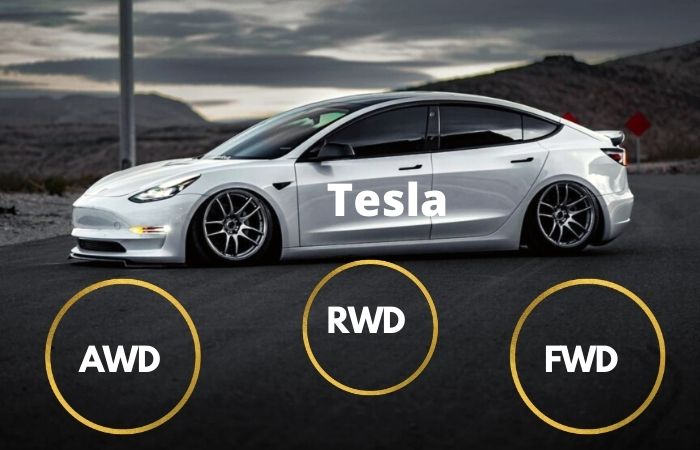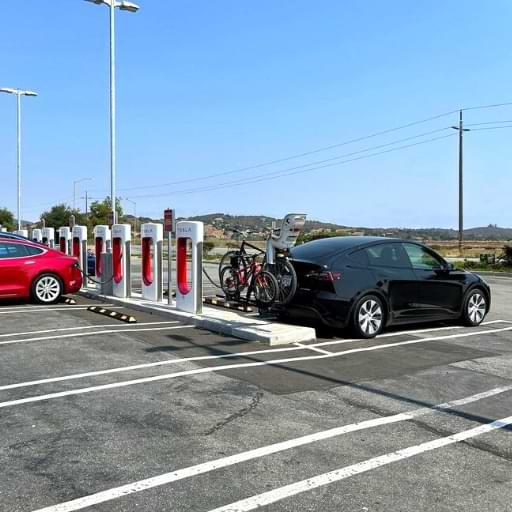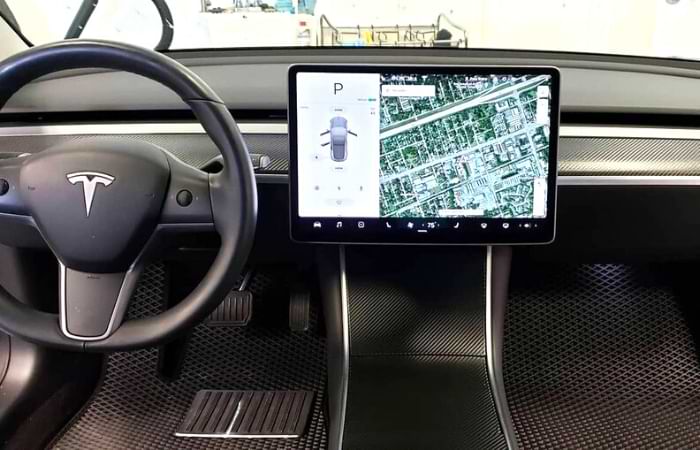How good are Tesla Model 3 AWD, RWD, and FWD?
We use affiliate links and may receive a small commission on purchases. Read more about us.
Considering the condition of the road, the driving mode is always an important aspect.
When the low-budget Tesla Model3 first hit the market, we were as curious as you to find out how better Model 3 would perform in either on a snowy track or on a typical road condition.
Since then, Model 3 has come a long way, and it is the right time to talk about the performance of Model 3 FWD, AWD, and RWD.
While the Model 3 FWD mode is safe but clumsy, the AWD and RWD mode is the best way to get the maximum fun of driving.
All the following sections are here to talk about everything you need to know about Tesla Model 3’s all driving modes.


Tesla Model 3 AWD VS RWD technical specifications
Category | Model 3 Performance | Model 3 long-range AWD | Model 3 RWD |
Drive | Dual Motor AWD | Dual Motor AWD | Single Motor RWD |
Range | 315 miles | 358 miles | 272 miles |
Acceleration | 3.1s/0-60 mph | 4.2s/0-60mph | 5.8s/0-60mph |
For the Model 3, Tesla brings three variants to the market
The Model 3 Performance series is the most expensive Model 3 lineup that will allow you to shift the driving mode to all three variants, including FWD, RWD, and AWD.
The Model 3 Performance comes with a range of 315 miles and takes around 3.1 seconds to get the acceleration speed of 60mph.
On the other part, the Long Range AWD edition comes with a range of 358 miles and the acceleration time is 4.2 seconds to reach 60mph.
Finally, the Model 3 RWD comes with a range of 272 miles and can get a speed of 60mph for about 5.8 seconds.
Tesla Model 3 FWD VS RWD VS AWD- which one is the best in the snow?


Everyone knows that an AWD is always a better choice to drive with more controllability in the snow.
How much does the Tesla Model 3 fare in terms of driving?
To find that out, we have brought our own Tesla Model 3 Performance with a range of 315 miles.
If you don’t know yet, the Model 3 Performance series will allow you to toggle the drive mode among 100% FWD, 100% RWD, and somewhere in between these two.
To complete the test, we have had our own track built with enough excessiveness so that we can test out with accuracy the condition of the driving of all these three modes of driving.
We are starting our test with the100% FWD Mode.
Tesla Model 3 in FWD only
In the FWD-only mode, Our Tesla Model 3 took nearly 102.5 seconds.
One thing we would love to mention is that even if you are driving in the FWD mode only on a straight track, you will notice that the Tesla is actually going somewhere in between the 100% FWD and 100% RWD.
Probably that happens because Tesla wants to offer 100% safety with each of the driving modes.
Tesla Model 3 in 100% RWD mode
Unless you are driving the Model 3 on a straight line, we can assure you that with the RWD mode of driving, you will have the real fun and excitement that you want to get from the Model.
Tesla Model in the RWD mode did fairly well while turning on the sideways or taking a harsh turn.
Most astonishingly, we could complete the lap with a fair timing of 99.5 seconds only.
That suggests that Tesla Model 3 in RWD mode is better capable of handling the snowy road than the FWD edition.
But what about driving in the AWD mode? Well, let’s find out-
Tesla Model 3 in AWD mode
It was quite natural, and it happened what was actually bound to happen.
To complete our own specified track, the Tesla Model 3 in the 50/50 or AWD Mode took nearly 95.5 seconds for one lap.
If you have the Performance series of Model 3 and you have to drive on a snowy track most often, the AWD is the ideal choice to have.
Analytical comparison among Tesla Model 3 FWD, RWD, and AWD
Drive Mode | Lap timing |
FWD | 102.5 seconds |
RWD | 99.5 seconds |
50/50 or AWD | 95.5 seconds |
The chart essentially defines what your decision should be. At the same time, it is also true that the budget may play an important role in influencing your decision when you are thinking about purchasing a new Tesla Model 3.


But if you already have a Tesla Model 3 Performance series, the AWD or 50/50 driving mode is the best way to get the preferred performance you want to get from your vehicle.
Tesla FWD, RWD, and AWD in typical road conditions
You surely are not going to drive your Tesla all the time on a snowy track.
Therefore, the performance of all the driving modes in typical road conditions is also an important aspect that should get better concentration.
Here is our opinion about all three driving modes of Tesla Model 3-
Model 3 FWD is best for a novice rider who prefers having maximum safety
Having the balance on the front side of the vehicle, the Tesla Model 3 in FWD mode brings maximum safety for a novice rider.
Therefore, if you are driving on a flat road where acceleration and deceleration are the only things you need to do, the FWD is the safest way of driving.
Model 3 RWD is best for roads with more turns and sideways
When you are driving your Tesla Model 3 on a low-traction road, and you need to take severe turns occasionally, the RWD mode might be the best option for driving.
Having the transmitted power to the back part of the car, the RWD on Tesla Model 3 will give you more access to controllability.
Model 3 AWD is for having a dynamic driving experience in all road conditions
Only driving is not the primary purpose of driving. Some eccentric drivers will always want to have the best experience and feel while driving.
That is when shifting your driving mode to the AWD mode can bring forth essential experience and performance leverage.
With dual motors and the balance point staying in the middle, the Tesla Model 3 in AWD will deliver better acceleration and controllability at the same time.
To all those eccentric Tesla Fans, here is your Tesla Model 3 in the AWD mode to make your driving more exciting.
Model 3 Performance in the FWD is more fuel-efficient
If you are a Tesla fan, you might want to know more about the fuel economy of all three driving modes.
Unlike the RWD edition, the long-range and performance AWD editions come with two motors.
Therefore, it is quite logical to think that the RWD edition with its single rear-drive motor will show the signs of more fuel economy. But it will show signs of draining the battery faster.
On the flip side of the coin, when you are driving the Model 3 Performance, driving in the FWD mode should show the signs of better fuel economy as this one will only employ power on the front side of the vehicle.
The RWD and AWD mode in performance needs to use more power of the engine for better acceleration and controllability.
Therefore, fuel economy will naturally drop a little compared to the FWD mode.
Cost of Tesla Model 3 RWD and AWD
Model 3 variants | Cost |
RWD | $39,940 |
AWD (Long range) | $45,940 |
AWD (Performance) | $53,940 |
By now, the cost of the Tesla Model 3 RWD starts at $39,940.
This one is the most basic and cheapest car offered by Tesla. With one motor placed on the rear part of the car, this one is better capable of delivering better control.
The Model 3 Long-range with all-wheel driving mode and two motors placed on the front and rear part of the car is available at $45,940.
This one is almost the same as the Performance series except for the range and acceleration.
Finally, the Model 3 Performance comes with the most expensive price range and superior acceleration capability is available at $53,940.
Model 3 RWD or AWD: which one is the better choice?


There is no doubt about the fact that the Tesla Model 3 AWD is always the better option because of its superior acceleration and performance capacity.
But when it comes to taking a decision, the budget is the crucial aspect that tends to dominate over the decision.
If it is the first time you are thinking about having a Tesla and you do not want to spend a lot of your budget on the car, the basic RWD might be the most ideal choice you can make.
On the contrary, if you want to explore the luxury of driving, the Model 3 Performance is the best suit for any occasion. But you might go with it only when you have a sufficient amount.
And finally, if you want to choose anything between Model 3 basic and performance, the long-range is waiting for you.
Keep in mind that Long Range RWD is still a better choice for the budget and efficiency.
If you have, by any chance, scanned through the whole article, you might generate a belief that Tesla Model 3 is not as performing as the Performance and Long Range AWD.
But there are still two primary reasons why Model 3 long-range RWD should stay in your consideration.
First of all, you will get better efficiency from the RWD in every aspect of its presentation.
As this beautiful car will only drive on a single motor, it will have more balance on each end. Therefore, efficiency will be highly ensured.
Finally, the economic budget is also a great reason why this one might be the thing you are looking for.
C’mon, everyone wants to own a Tesla. With a budget of nearly $35,000, it is now possible to get one.
Go and take the chance if you are interested. It’s your turn now.
Let’s learn about Driving modes now for a while
All the things we have discussed above will go in vain if you do not have any knowledge about the drive mode of a car.
When it comes to driving a car, three terms essentially show up.
The FWD stands for Front Wheel drive which says that the engine's power of an FWD vehicle is only to be delivered to the front wheels of the car.
On the contrary, only the rear wheels of an RWD (Rear Wheel Drive) vehicle will receive the power of the engine.
And finally, the AWD (All Wheel Drive) will receive the power of the engine in all of the wheels of the car.
The Pros and cons of FWD, AWD, and RWD
Front-Wheel Drive cars
Having the transmitted power on the front wheels, FWD cars are better capable of delivering traction while climbing on a hilly track.
At the same time, an FWD car is fuel-efficient, cheaper, and can deliver more space.
Rear Wheel Drive car
The limitations of an FWD car are the plus points of an RWD-powered car.
Where an FWD car dramatically fails to handle a low-traction road, an RWD transmitted car delivers the most efficient control in low-traction roads.
Therefore, these vehicles are a better companion when you want better controllability over the car.
All Wheel Drive
Finally, an AWD car is more like a hybrid of the previous two versions.
Getting the engine power in all of the wheels allows such vehicles to handle almost all-terrain conditions.
At the same time, these vehicles will require to have more parts which make them costlier compared to their two other counterparts.
Final summary
We are not here to decide whether you should go with a Tesla RWD or AWD. But we can definitely help you to make a better decision in the longerrun. And that is what we have tried throughout the whole article. We hope all these insights will help you to choose better in the course of your life.











